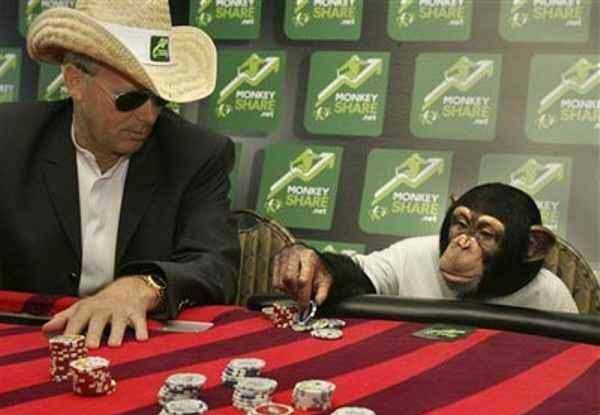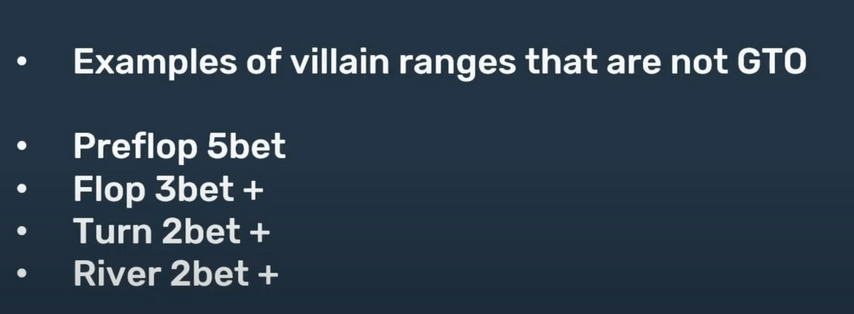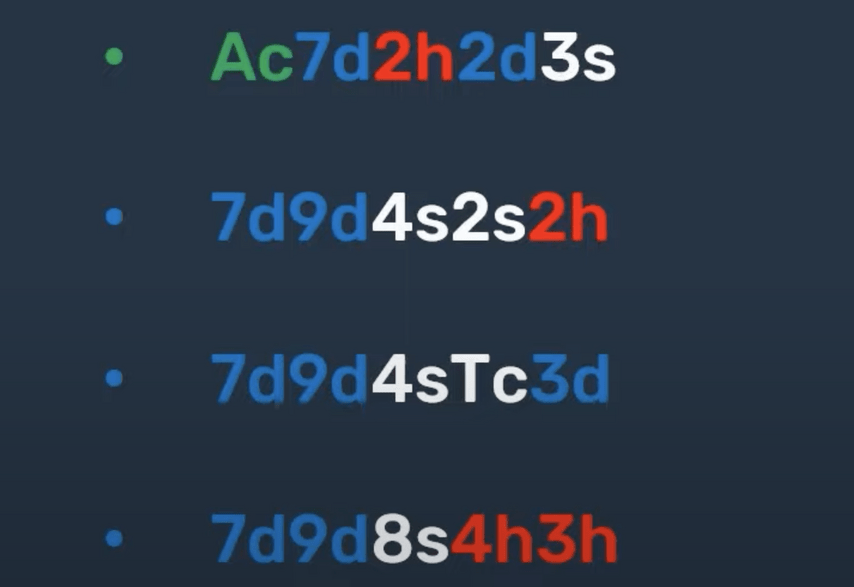A video has been released on the Red Chip Poker channel to help beginners and mid-stakes players choose the most profitable situations for bluffs and bluff catching, teach them how to react to overbet, and cure the "monster under the bed" syndrome.
Principle One
Probabilities

If we are guided by this principle, then we are not interested in what the opponent may have, because all being the same, no option can be ruled out. Yes, it could turn out that Villain flopped four of a kind and decided to slowplay it to the river. It's also possible that the Villain has 72o, but he hits a full house after check-raising the flop.
Anything can happen. In poker, we will never be able to completely exclude a particular hand from our opponent's range. Even if he doesn't normally play the hand this way, there is always the possibility of a misclick. If we talk too much about what our opponent might have, we run the risk of the monster under the bed syndrome. What if the Villain caught running Quads and ran over our full house? Thinking like that during the hand will not help you.
Instead, we should focus on the most likely opponent's pocket cards rather than hypothetical scenarios. This principle allows us to very aggressively remove combinations from the opponent's range, even if he theoretically still has the probability of having certain cards. A simple example is we make a small continuation bet, our opponent calls the bet, and doesn't check-raise. Although he can still have a slow-played set, it's not that big of a deal for us, we can remove these combos from the most likely ones. If later on it turns out that he actually had a set and slowplayed, then we still made the best decision based on the information that we had at that time. Of course, in the future, we will write notes on the opponent and adjust our ideas about his range for the future.
If Villain is representing something incredible that he can't possibly have based on his preflop play, it's perfectly normal to assume that he doesn't have that hand. If it later turns out that our opponent is playing many more hand preflop than we thought, we can adjust to that. For example – we open UTG and get a 3-bet. On a 7-5-4 flop, we don't believe our opponent has 8-6 straight. It's possible, of course, but is it likely? – No. And those who read hands well think about what is most likely.
Principle Two
Dripped Range
Another key concept important for hand reading. Let's start with a simple example – imagine you opened the button with aces and the flop came . Not the most pleasant texture for us, we can assume that the range of the player who made the call fits this flop better. Regardless, our aces are still likely the best hand, so we should keep betting. In this spot, if our opponent has 99, 88, or 44, we expect to see a check raise. If he has 98s or 98o, then we also expect a check-raise.
That doesn't mean he always check-raises with sets or two pair. If an opponent is trying to play GTO, he must sometimes choose to check-call, so we can't completely rule out strong hands, but remember our first principle – we want to focus on the most likely scenarios. Most players with a set or two pair here will check-raise our continuation bet. This way we can read our opponent's hand quite effectively – if he check-calls on a 984 board, he usually won't have sets and two pair, most likely he has one pair, like T-9, or some sort of draw. – gutshots with QJ, QT, straight draws with JT.
In other words, when our opponent calls in this spot, he is giving us the information that we now have the best hand most of the time. Of course, the next cards may change that. Let's compare two turns – and . Let's start with a deuce – how does this blank card affect the relative strength of our hand? If our hand was strong enough on the flop, it turned into a monster on the turn. We didn't improve, but in fact, our hand turned into the nuts. All of the hands we lost to on the flop were eliminated from our opponent's range, leaving him with only pairs or draws, and they all caught a brick on the turn. Thus, the aces from a fairly strong hand turned into the nuts on such a turn. The important thing to understand here is that this allows us to overbet the turn because we think we have the best hand.
If the turn is a seven ( ), which gives another potential flush draw, then the situation will not be so rosy for aces. Some one-pair hands and draws have improved to a straight or two-pair. And if the flush hit on the turn, then you had to be even more careful with aces.
This example illustrates the general principle well – if you are working with a solver, you will see reduced sizing on flush closing turns. When a flop comes with a texture that has a lot of live draws but none of them improved on the turn, the solver advises to overbet with a high frequency because Villain's range will be capped. This even works in the world of solvers, where opponents slowplay to protect their check-call range. Now consider how this works against players who always check-raise sets and two pair – their range will fold very heavily to the nuts. The most important hand-reading principle is to be able to tell when an opponent's range is capped and when it isn't, and we need to be more careful with our bet sizing.
Another concept that can be mentioned in this paragraph is passive or active hand reading. Passive is when we simply observe the actions of the opponent and try to draw conclusions about the strength of his hand. The opponent's actions are a response to our bets and their size. For example, if we decided to overbet already on the flop and got called, we couldn't be so sure that he would fold to the nuts on a blank turn. The more we bet, the more our opponent will be inclined to slowplay with a top set, as he may assume that he will get another overbet from us on the turn. When we use ineffective sizing, we greatly limit the information that we can get depending on the actions of the opponent. However, if we can pick a sizing that is big enough to get value and protect the hand, but still modest enough, To make it profitable for the opponent to check-raise his sets and two pair, we can say that in this situation we are engaged in active hand reading. That is, we purposefully choose actions that will collect the maximum amount of information about the opponent's range.
Principle Three
Unusual draw lines

You have probably found yourself in situations where the opponent chooses actions that seem illogical and occur infrequently. For example, double check-raise – the player check-raises the flop and checks on the turn. We think, “Yeah, he wanted to knock us out of the hand, and now he gives up,” so we calmly bet the turn and run into a check-raise again. Or our opponent checks the flop, so do we, on the turn he checks again, we calmly bet, but we get raised. It doesn't seem to make any sense – if you have a good hand, then bet the turn instead of check. Here are some considerations related to unusual draw lines.
Most of the time, players won't create much when bluffing. When an opponent has nothing, he will often worry that his unusual actions may be seen as a bluff. However, when someone actually hits top set or another nut hand, the situation changes – he worries that we will often fold in straightforward play.
A general piece of advice to give in this situation is if you come across a very creative and unusual play, consider it value by default. Of course, this does not work 100% and will not always be true, it all depends on the specific opponent. However, there is nothing wrong with trusting your gut on these silly lines.
Principle Four
The further into the forest...

The idea is that the early streets are played close to the GTO. If the solver c-bets the flop 65% of the time, then the player should do the same. However, the more raises and reraises there were preflop, the more the real game deviates from the recommendations of the solver.
Let's take a simple example of 5-betting preflop. If we look at the real range of players, it turns out to be much stronger than how the solver plays. The solver will 5-bet with some weak pairs, hands like A6s, while in the real world, there are quite a few players who 5-bet exclusively with QQ+ or JJ+ and AK. This difference becomes even more pronounced when it comes to later streets.
Take a hand with a 3-bet on the flop – one player bets the flop, gets raised or check-raised, and reraises. The solver in this situation has speculative hands – weak pairs, for example. In reality, most people don't 3-bet the flop without the ironclad nuts. The same logic can be applied to turn and river raises – the action after the reraise is heavily skewed towards the nuts, while the solver will always have some speculative hands. While light raises are common on the flop, 3-betting on the flop is almost always the nuts, and if we go further, even raises are played with very strong hands. For example, raising on the turn has a lot more power than 3-betting the flop, and raising on the river is almost always the nuts.

Thus, the further we move along the streets, the more our opponent's range deviates from the solver towards tighter.
Principle Five
What the sizings say

A pot-sized bet is usually a measure of strength. If you look into the solver, there will be quite a lot of bluffs in this sizing, but our opponent will not necessarily have at least one of these bluffs, some only bet the pot with the nuts. If we face a pot bet on the flop, then this can be considered a sign of strength, but if we are potted both on the flop and on the turn, then in most cases our opponent has a very strong hand. If they are pot-betting three streets in a row, which isn't very common, we can safely put our opponent on the nuts.
Overbets are also indicative of strength, but more and more players are using them with bluffs. Interestingly, overbets usually hide a slightly weaker range than pot-bets. The other side of the coin here is that we need to pay more, so we won't always defend more against overbets.
What's even more interesting is that an overbet push is usually weaker than a regular overbet. A fairly common situation is a 3-bet pot where our opponent raises our continuation bet. Let's say we 3-bet preflop with aces, get called, c-bet the flop, and our opponent raises. On the one hand, we have an overpair and we should not fold it, on the other hand, our opponent could flop a set or something else. In most cases, we can only get information from our sizing.
Let's look at three options, the first – our opponent makes a min-raise. On the one hand, this indicates strength, but on the other hand, we get excellent continuation conditions, so we usually press call and wait for the next street. The problem arises when the Villain makes a 2.5-3X raise – big enough already, but not all-in yet. We usually don't fold overpairs in 3-bet pots, but this sizing can tell us that our opponent is very strong, his range can be full sets, which means this is a great situation for an exploit and a hero fold. However, if your opponent is pushing to a c-bet, you should almost always be inclined to call. Why? An overbet push in this situation is always much weaker than a 2.5-3x raise.
Different players use sizing differently. Regulars, for example, often bet pots but rarely overbet, even if they should be using a solver. Fish, on the other hand, use overbets more often. Even if we come across a very strong reg who uses overbets, it may turn out that he practically does not use overbet pushes, but the fish definitely love them very much.
Principle six
Player types

A key aspect of hand reading is the classification of opponents. A simple example of how we can use this information is that fish bluff more often than regulars.
The standard regular usually bluffs far less than the GTO requires. Only really strong regs bluff close to the solver. Most people play more tight-passive, especially on the river, and don't bluff as often as they should. And this gives us the opportunity to hero fold against these guys. But the average fish, on the contrary, usually bluffs more than it should according to the TRP. In other words, it is much more profitable to bluff catch against fish than against medium regs.
Fish also use merges more often. A merge is when there are also medium-strength hands in the polar range. When a normal reg bets the river, some of his hands will be for value, some will go to bluffs, but he will have practically no middle hands, since almost all of them should be a check. Betting medium-strength hands on the river is simply unreasonable in most situations. Of course, the fish don't know about this, so they sometimes bet hands on the river that doesn't make sense to bluff and can't extract value from them if they pay.
Most weak regs bluff less than they should. Nits, who can basically be called weak tight regulars, can sometimes show aggression, but only with a very narrow range. They also under-bluff the river.
You might be surprised how often the fish fold the river, even if they are more of a calling station. This is because they call the flop and turn very wide, and by the river, there are too many hands in their range that should fold, such as missed gutshots with J-high. Even classic stations with this kind of trash won't river call, so this is the perfect opportunity to try and knock them out of the pot. Nits, on the other hand, act in the opposite way – against them, we have a lot of fold equity on early streets, and a bunch of pots can simply be taken away with a continuation bet. But once a nit shows interest in the pot and calls the flop, much less the turn, we have very little fold equity against them on the river since nits have far fewer speculative hands to begin with.
I hope these examples show how important it is to read hands to notice the tendencies of opponents.
Principle seven
Board texture

First, let's take a look at the dry board. If Villain calls us in this situation, then he probably has a made hand. If we're facing three bets on this texture, it's unlikely Villain will have a bluff on the river, simply because players prefer semi-bluffs that can at least theoretically improve over pure turn bluffs.
On the other hand, if we were on a very coordinated flop, the turn added more likely draws, but didn't close any, and the river came a blank – our opponent will not only fold more often, but also, if he acts as an aggressor, bluff more often, since a lot of hands in his range didn't make it to the river. But on a board where a draw hit on the turn and a few more could hit on the river, our opponent will fold less often and bluff less often.
Good players know that if they hit a lot of draws, they can turn pairs into bluffs in order to have enough bluffs in their range. However, average players don't think about it and often under-bluff in these situations. Another aspect is that many people call too often in this situation, and fold too often on boards with missed draws because they think about the absolute strength of their hand, and not about ranges.
In conclusion, let's look at a situation in which the straights could have been made on the flop, but the turn and river did not change anything. It is quite likely that on such a board our opponent will bluff more than they should and fold too often if we are the aggressor. However, remember, the best situation for bluffs and bluff catches is when there are a lot of draws on the flop, more of them came on the turn, but none of them made it to the river.











